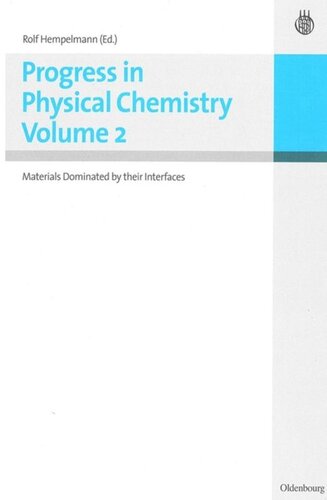

Most ebook files are in PDF format, so you can easily read them using various software such as Foxit Reader or directly on the Google Chrome browser.
Some ebook files are released by publishers in other formats such as .awz, .mobi, .epub, .fb2, etc. You may need to install specific software to read these formats on mobile/PC, such as Calibre.
Please read the tutorial at this link: https://ebookbell.com/faq
We offer FREE conversion to the popular formats you request; however, this may take some time. Therefore, right after payment, please email us, and we will try to provide the service as quickly as possible.
For some exceptional file formats or broken links (if any), please refrain from opening any disputes. Instead, email us first, and we will try to assist within a maximum of 6 hours.
EbookBell Team

4.1
90 reviewsProgress in Physical Chemistry is a collection of recent “Review Articles” published in the “Zeitschrift für Physikalische Chemie”. The aim of a “Review article” is to give a profound survey on a special topic outlining the history, development, state of the art and future research. Collecting these articles the Editors of Zeitschrift für Physikalische Chemie intend to counteract the expanding flood of papers and thereby give students and researchers a means to obtain fundamental knowledge on their special interest. The second volume of Progress in Physical Chemistry is a collection of thematically closely related minireview articles written by the members of the Collaborative Research Centre (SFB) 277 of the German Research Foundation (DFG). These articles are based on twelve years of intense coordinated research efforts. Central topics are the synthesis and the characterization of interface-dominated, i.e. nanostructured materials, mainly in the solid state but also as nanoparticles / nanorods in liquid dispersion (ferrofluids) or as gas / liquid in mesoporous host systems (thermodynamics in confinement). For the synthesis physical vapour deposition (PVD), chemical vapour deposition (CVD), electrochemistry, and various sol-gel and microemulsion routes are employed. For the characterization a broad spectrum of methods from physics, materials science and physical chemistry is used, like scattering methods, nuclear hyperfine interaction methods and different types of scanning probe microscopy. The correlation between, on the one hand, the nanostructure and, on the other hand, the thermodynamics, the magnetic and mechanical properties specific to the nanometre scale as well as the theoretical modelling of the same are in the focus of the scientific interest.